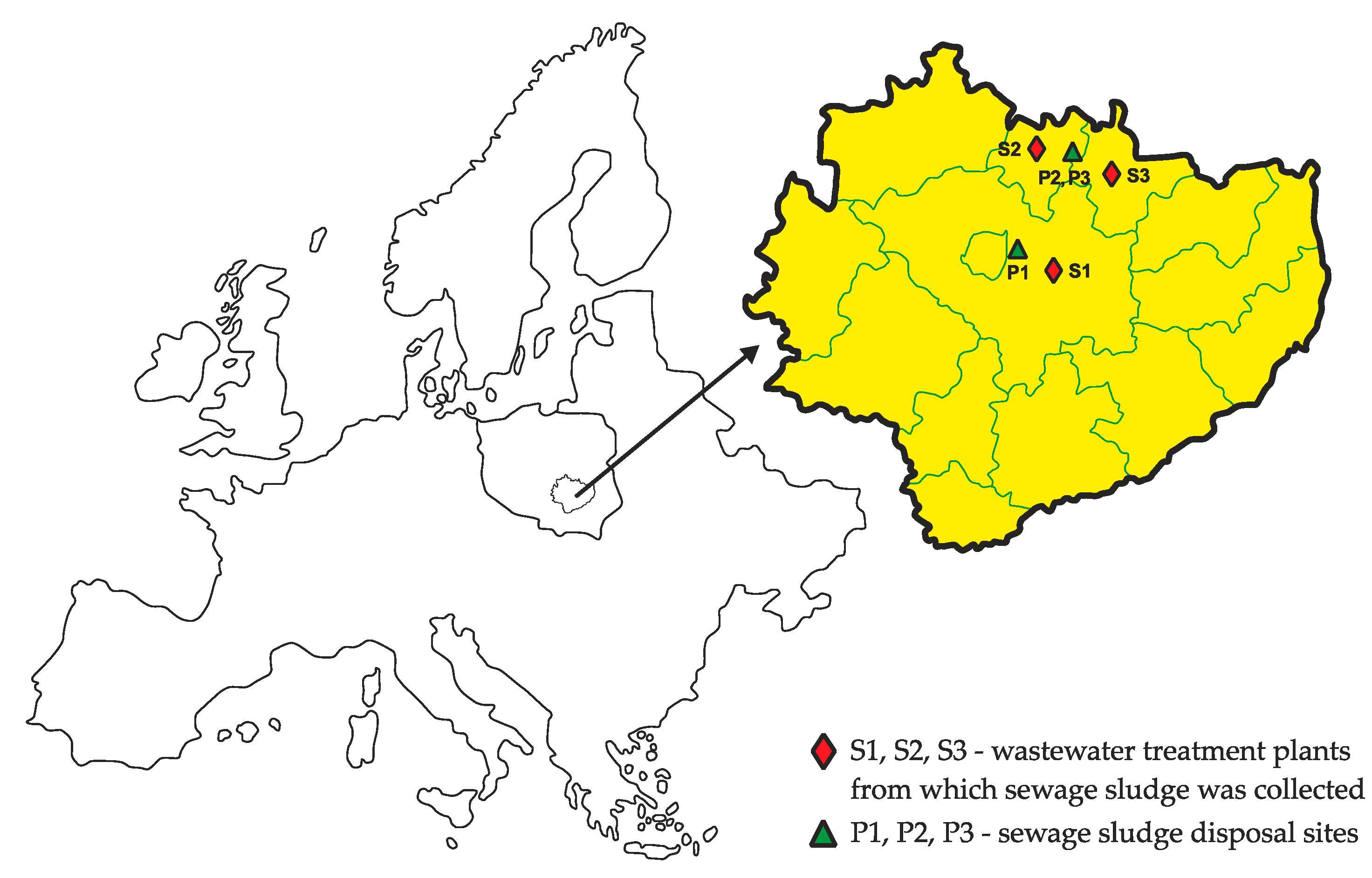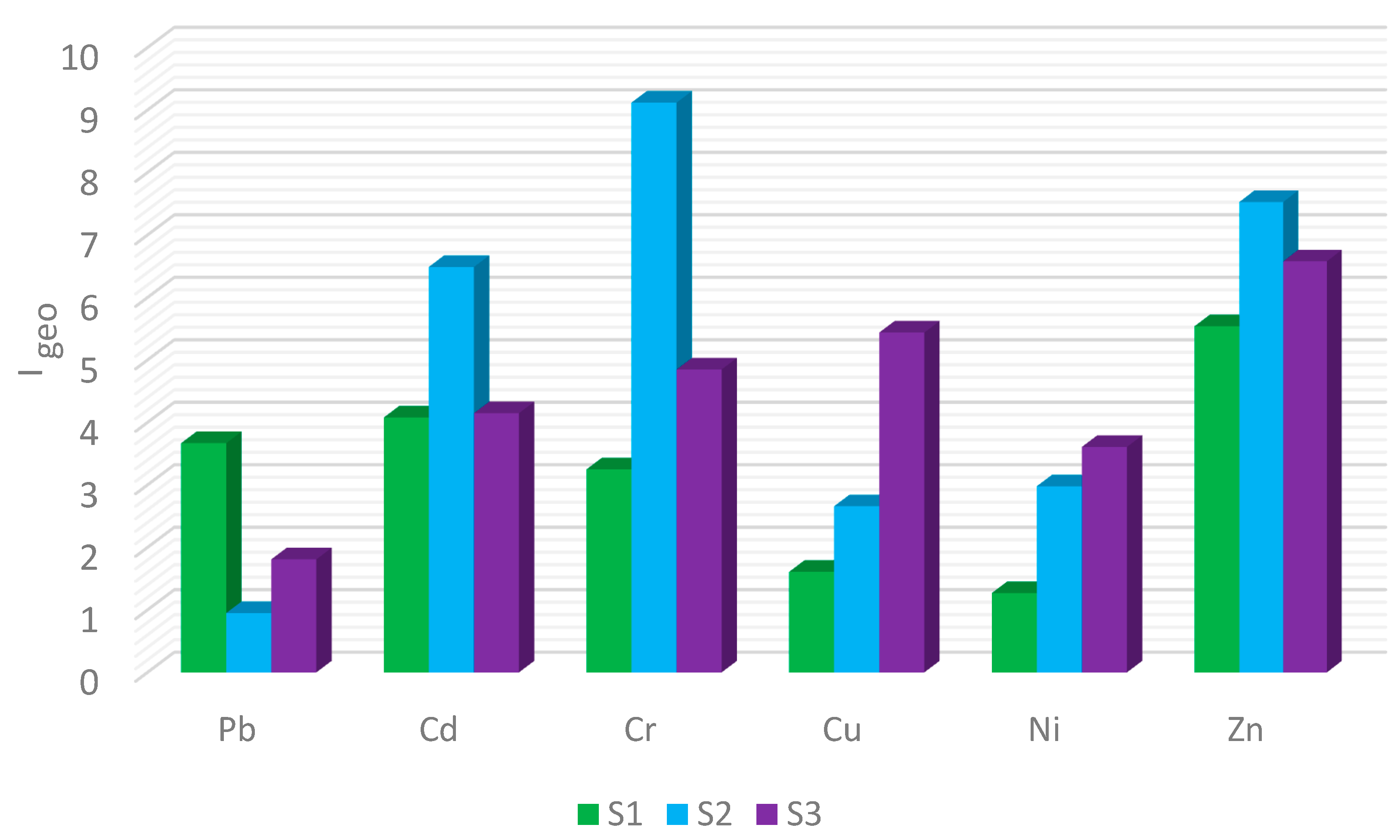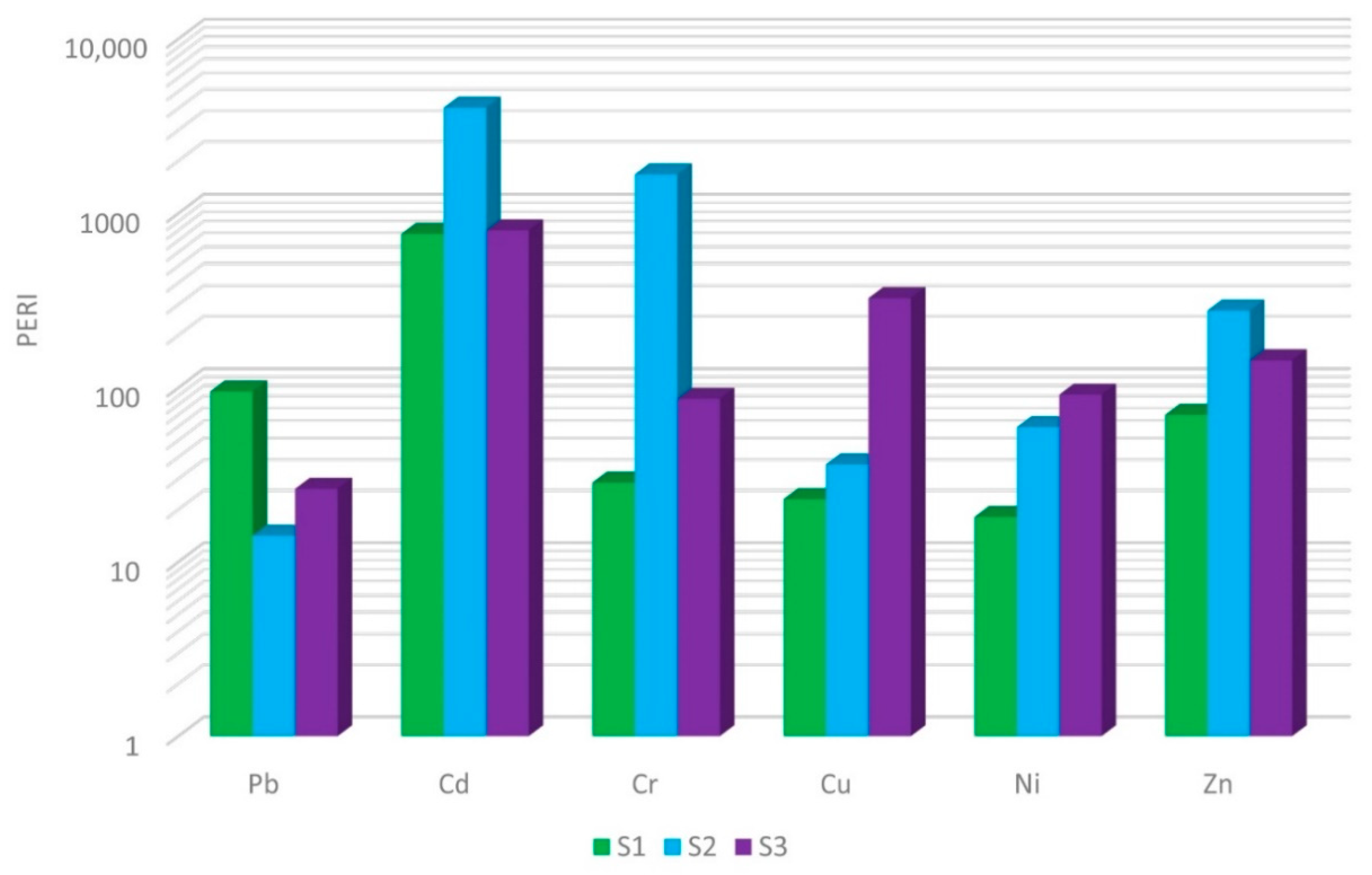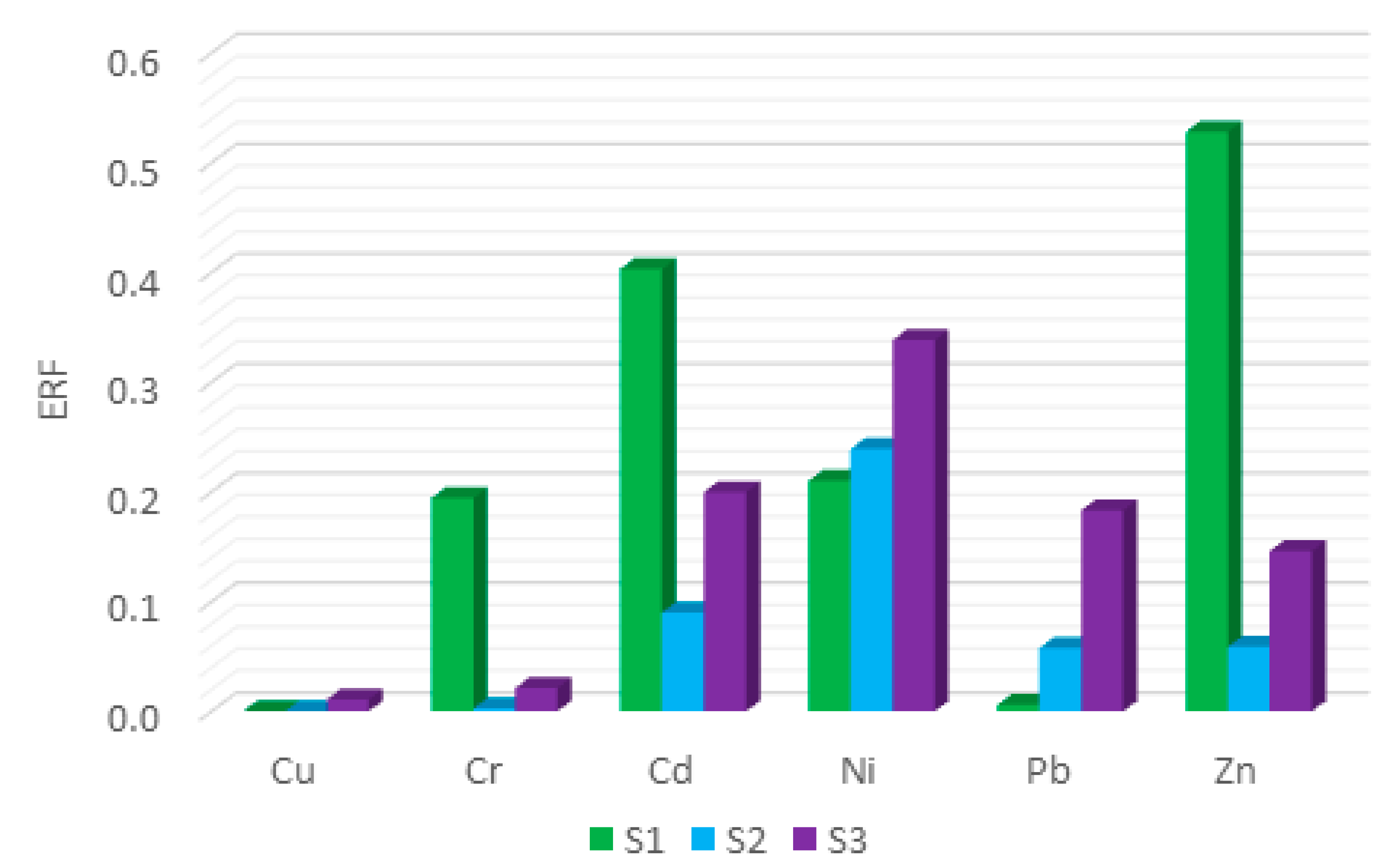Risk Assessment of Soil Contamination with Heavy Metals from Municipal Sewage Sludge
Abstract
:Featured Application
Abstract
1. Introduction
2. Materials and Methods
2.1. Materials
2.2. Mobility of Heavy Metals of Sewage Sludge
- Stage I: extraction CH3COOH—for determination of the content of assimilable and carbonate-bound metals (fraction FI—interchangeable; mobile);
- Stage II: extraction NH2OH·HCl—for determination of the content of metals associated with amorphous iron and manganese oxides (fraction FII—reductive; mobile);
- Stage III: extraction H2O2/CH3COONH4—for determination of the content of the organometallic and sulphide fraction (fraction FIII—oxidising; potentially mobile);
- Stage IV: mineralisation of the residual fraction with a mixture of concentrated acids (HCl, HF, HNO3)—for determination of the content of metals bound to silicates (fraction FIV—residual; immobile).
2.3. Contamination Assessment Methodology
2.3.1. Risk Assessment Code (RAC)
2.3.2. Environmental Risk Factor (ERF)
2.3.3. Environmental Risk Determinant (ERD)
3. Research Results and Discussion
4. Conclusions
Author Contributions
Funding
Institutional Review Board Statement
Informed Consent Statement
Conflicts of Interest
References
- Statistics Poland. Statistical Yearbook of the Regions 2019; Statistics Poland: Warsaw, Poland, 2020. [Google Scholar]
- Ondreičková, K.; Gubišová, M.; Piliarová, M.; Horník, M.; Matušinský, P.; Gubiš, J.; Klčová, L.; Hudcovicová, M.; Kraic, J. Responses of Rhizosphere Fungal Communities to the Sewage Sludge Application into the Soil. Microorganisms 2019, 7, 505. [Google Scholar] [CrossRef] [PubMed] [Green Version]
- Latosińska, J. Risk assessment of soil contamination with heavy metals from sewage sludge and ash after its incineration. Desalin. Water Treat. 2020, 199, 297–306. [Google Scholar] [CrossRef]
- Kujawska, J.; Wójckik-Oliveira, K. Ecotoxicological assessment of the soil fertilized with sewage sludge. Present Environ. Sustain. Dev. 2020, 14, 131–146. [Google Scholar] [CrossRef]
- Farasat, S.; Namli, A. Evaluating effects of sewage sludge on soil biochemical properties amounts (incubation experiment). Fresen. Environ. Bull. 2016, 25, 1484–1493. [Google Scholar]
- Lasaridi, K.-E.; Manios, T.; Stamatiadis, S.; Chroni, C.; Kyriacou, A. The Evaluation of Hazards to Man and the Environment during the Composting of Sewage Sludge. Sustainability 2018, 10, 2618. [Google Scholar] [CrossRef] [Green Version]
- Latosińska, J. Influence of temperature and time of sewage sludge incineration on the mobility of heavy metals. Environ. Prot. Eng. 2017, 43, 105–122. [Google Scholar] [CrossRef]
- Waste Act (J.L. 2013, No. 0, item. 21). Available online: https://isap.sejm.gov.pl/isap.nsf/download.xsp/WDU20130000021/O/D20130021.pdf (accessed on 20 December 2020).
- Minister of the Environment. Regulation of the Minister of the Environment of 6 February 2015 on the Municipal Sewage Sludge (J. L. 2015, No. 0, item. 257); Minister of the Environment: Warsaw, Poland, 2015.
- Minister of the Economy. Regulation of the Minister of the Economy of 16 of 16 July 2015 on the Acceptance of Waste for Landfilling (J.L. 2015, No.0, item. 1277); Minister of the Economy: Warsaw, Poland, 2015.
- European Commission. Council Directive of 12 June 1986 on the Protection of the Environment, and in Particular of the Soil, When Sewage Sludge Is Used in Agriculture (86/278/EEC); European Commission: Brussels, Belgium, 1986. [Google Scholar]
- Code of Federal Regulations. Protection of Environment. Chapter I—Environmental Protection Agency (Continued), Subchapter O—Sewage Sludge, Part 503—Standards for The Use Or Disposal Of Sewage Sludge, Subpart B—Land Application, Section 503.13—Pollutant limits. July 1, 2010; Office of the Federal Register (United States): Washington, DC, USA, 2010.
- Ministry of Environmental Protection of the People’s Republic of China. Discharge Standard of Pollutants for Municipal Wastewater Treatment Plant; Ministry of Environmental Protection of the People’s Republic of China: Beijing, China, 2002.
- Water Research Commission. Guidelines for the Utilisation and Disposal of Wastewater Sludge. Vol. 2. Requirements for the Agricultural Use of Wastewater Sludge; WRC Report no: TT 262/06; WRC: Pretoria, South Africa, 2009. [Google Scholar]
- Werther, J.; Ogada, T. Sewage sludge combustion. Prog. Energy Combust. Sci. 1999, 25, 55–116. [Google Scholar] [CrossRef]
- Smiljanić, S.; Tesan-Tomić, N.; Perusic, M. The Main Sources of Heavy Metals in the Soil and Pathways Intake. In Proceedings of the Conference: Europen Energy Market, Ljubliana, Slovenia, 18–20 September 2019. [Google Scholar]
- Wuana, R.A.; Okieimen, F.E. Heavy Metals in Contaminated Soils: A Review of Sources, Chemistry, Risks and Best Available Strategies for Remediation. Int. Sch. Res. Not. 2011. [Google Scholar] [CrossRef] [Green Version]
- Weissmannová, H.D.; Pavlovskȳ, J. Indices of soil contamination by heavy metals—Methodology of calculation for pollution assessment (minireview). Environ. Monit. Assess. 2017, 189, 1–25. [Google Scholar] [CrossRef]
- Correia, A.A.S.; Matos, M.P.S.R.; Gomes, A.R.; Rasteiro, M.G. Immobilization of Heavy Metals in Contaminated Soils–Performance Assessment in Conditions Similar to a Real Scenario. Appl. Sci. 2020, 10, 7950. [Google Scholar] [CrossRef]
- Gawdzik, J. Mobility of Selected Heavy Metals in Sewage Sludge; Technical University of Kielce: Kielce, Poland, 2013. [Google Scholar]
- Bezak-Mazur, E. Specjacja w Ochronie i Inżynierii Środowiska; Polska Akademia Nauk: Kielce, Poland, 2014. [Google Scholar]
- Zwain, H.; Vakili, M.; Dahlan, I. Waste Material Adsorbents for Zinc Removal from Wastewater: A Comprehensive Review. Int. J. Chem. Eng. 2014, 2014. [Google Scholar] [CrossRef]
- Xiang, L.; Chan, L.C.; Wong, J.W.C. Removal of heavy metals from anaerobically digested sewage sludge by isolated indigenous iron-oxidizing bacteria. Chemosphere 2000, 41, 283–287. [Google Scholar] [CrossRef]
- Ryu, H.W.; Moon, H.S.; Lee, E.Y.; Cho, K.S.; Choi, H. Leaching characteristics of heavy metals from sewage sludge by Acidithiobacillus thiooxidans MET. J. Environ. Qual. 2003, 32, 751–759. [Google Scholar] [CrossRef] [PubMed]
- Linde, M.; Bengtsson, H.; Öborn, I. Concentrations and Pools of Heavy Metals in Urban Soils in Stockholm, Sweden. Water Air Soil Pollut. Focus 2001, 1, 83–101. [Google Scholar] [CrossRef]
- Soil Contamination with Heavy Metals. Available online: http://www.zgora.pios.gov.pl/wp-content/uploads/2017/11/8_STAN-ZANIECZYSZCZENIA-GLEB-METALAMI-CI%C4%98%C5%BBKIMI.pdf (accessed on 1 October 2020).
- The Chief Inspectorate of Environmental Protection. Available online: http://www.gios.gov.pl/pl/stan-srodowiska/monitoring-jakosci-gleby-i-ziemi (accessed on 12 September 2020).
- The Chief Inspectorate of Environmental Protection. Available online: https://www.gios.gov.pl/chemizm_gleb/index.php?mod=pomiary&w=26 (accessed on 12 September 2020).
- Gawdzik, J. Mobility of heavy metals in sewage sludge on the example of a selected sewage treatment plan. Eng. Environ. Prot. 2015, 15, 5–15. [Google Scholar]
- Żelezik, M.; Gawdzik, J. The content of heavy metals species in sewage sludge from wastewater treatment plants in Mniów. Arch. Waste Water Manag. Environ. Prot. 2015, 17, 119–126. [Google Scholar]
- Mizerna, K.; Król, A. Sequential extraction of heavy metals in mineral-organic composite. Ecol. Eng. Environ. Technol. 2018, 19, 23–29. [Google Scholar] [CrossRef]
- Chen, M.; Li, X.-M.; Yan, Q.; Zeng, G.-M.; Zhang, Y.; Liao, D.X.; Liu, J.-J.; Hu, J.-M.; Guo, L. Total concentrations and speciation of heavy metals in municipal sludge from Changsha, Zhuzhou and Xiangtan in middle-south region of China. J. Hazard. Mater. 2008, 160, 324–329. [Google Scholar] [CrossRef]
- Müller, G. Index of geo-accumulation in sediments of the Rhine River. Geol. J. 1969, 3, 108–118. [Google Scholar]
- Huang, H.; Yuan, X.; Zeng, G. Quantitative evaluation of heavy metals’ pollution hazards in liquefaction residues of sewage sludge. Bioresour. Technol. 2011, 102, 10346–10351. [Google Scholar] [CrossRef]
- Latosińska, J.; Czapik, P. The Ecological Risk Assessment and the Chemical Speciation of Heavy Metals in Ash after the Incineration of Municipal Sewage Sludge. Sustainability 2020, 12, 6517. [Google Scholar] [CrossRef]
- Håkanson, L. An ecological risk index for aquatic pollution control. A sedimentological approach. Water Res. 1980, 14, 975–1001. [Google Scholar] [CrossRef]
- Xiao, Z.; Yuan, X.; Leng, L.; Jiang, L.; Leng, L.; Chen, X.; Zeng, G.; Li, F.; Cao, L. Chemical speciation, mobility and phyto-accessibility of heavy metals in fly ash and slag from combustion of pelletized municipal sewage sludge. Sci. Total Environ. 2015, 536, 774–783. [Google Scholar] [CrossRef] [PubMed]
- Czaplicka, A.; Ślusrczyk, Z.; Szarek-Gwiazda, E.; Bazan, S. Spatial distribution of iron and manganese in bottom sediments of the Goczałkowice Reservoir. Environ. Prot. 2017, 39, 47–54. [Google Scholar]
- Tytła, M. Assessment of heavy metal pollution and potential ecological risk in sewage sludge from municipal wastewater treatment plant located in the most industrialized region in Poland–Case study. J. Environ. Res. Public Health 2019, 16, 2430. [Google Scholar] [CrossRef] [Green Version]
- Xiao, Z.; Yuan, X.; Leng, L.; Jiang, L.; Chen, X.; Zhibin, W.; Xin, P.; Jiachao, Z.; Zeng, G. Risk assessment of heavy metals from combustion of pelletized municipal sewage sludge. Environ. Sci. Pollut. Res. 2016, 23, 3934–3942. [Google Scholar] [CrossRef]
- Wang, Y.; Pan, Y.; Shang, L.; Yue, Y.; Zhou, J.; Xu, Y.; Qian, G. Can washing-pretreatment eliminatethe health risk of municipal solid waste incineration fly ash reuse? Ecotoxicol. Environ. Saf. 2015, 111, 177–184. [Google Scholar] [CrossRef]
- Zhang, J.; Tian, Y.; Zhang, J.; Li, N.; Kong, L.; Yu, M.; Zuo, W. Distribution and risk assessment of heavy metals in sewage sludge after ozonation. Environ. Sci. Pollut. Res. 2017, 24, 5118–5125. [Google Scholar] [CrossRef]
- Singh, J.; Lee, B. Reduction of environmental availability and ecological risk of heavy metals in automobile shredder residues. Ecol. Eng. 2015, 81, 76–81. [Google Scholar] [CrossRef]
- Wang, C.; Hu, X.; Chen, M.L.; Wu, Y.H. Total concentrations as fractions of Cd, Cr, Pb, Cu, Ni and Zn in sewage sludge form municipal and industrial wastewater treatment plants. J Hazard Mater. 2005, 119, 245–249. [Google Scholar] [CrossRef]
- Plum, L.; Rink, L.; Haase, H. The Essential Toxin: Impact of Zinc on Human Health. Int. J. Environ. Res. Public Health 2010, 7, 1342–1365. [Google Scholar] [CrossRef] [PubMed] [Green Version]






| Metal | Permissible Values for Heavy Metals Intended for Natural Use, mg∙kg−1 d.m. | |||||
|---|---|---|---|---|---|---|
| Poland Regulation [8,9,10] | EU Directive 86/278/EEC [11] | Chinese Regulation GB 18918–2002 [13] | USA Regulation 40 CFR Part 503, 503.13 [11] | South African Guideline (Pollutant Class a) [14] | ||
| pH < 6.5 | pH > 6.5 | |||||
| Cd | 20 | 20–40 | 5 | 20 | 39 | 40 |
| Ni | 300 | 300–400 | 100 | 200 | 420 | 420 |
| Zn | 2500 | 2500–4000 | 500 | 1000 | 2800 | 2800 |
| Cu | 1000 | 1000–1750 | 250 | 500 | 1500 | 1500 |
| Cr | 500 | - | 600 | 1000 | - | 1200 |
| Pb | 750 | 750–1200 | 300 | 1000 | 300 | 300 |
| Metal | Industry Branches |
|---|---|
| Cadmium | Galvanising plants, manufacture of dyes, batteries, accumulators, paints and plastics, polymer stabilisers, chemical industry, manufacture of plant protection products, graphic and printing works |
| Lead | Production of dyes, accumulators, batteries, fertilisers, automotive industry, energy industry, plant protection products, electrochemical industry |
| Chromium | Electroplating; tanning; wood impregnation; textile, dye and plastic manufacturing; printing and graphic arts plants |
| Copper | Metallurgical, paint, textile, plant protection products and fertiliser industries |
| Mercury | Production of batteries, phosphoric acid, caustic soda, pulp mills, production of plant protection products, metallic mercury |
| Nickel | Electroplating industry, paper industry, refineries, steelworks, fertiliser factories |
| Zinc | Production of batteries, paints, textile industry, plastics, polymer stabilisers, printing and graphic arts |
| Location and Type of WWTP | Equivalent Number of Residents | Sewage Sludge Treatment | Location of Potential Disposal Sites of Sewage Sludge | Distance from WWTP to Potential Disposal Site of Sewage Sludge, km |
|---|---|---|---|---|
| Daleszyce mech.-biol. SBR | 5000 | Oxygen stablisation | P1—Wola Kopcowa | 13.5 |
| Skarżysko-Kamienna mech.-biol. hybrid | 59,500 | Fermentation | P2—Wąchock | 13.8 |
| Starachowice mech.-biol. SBR | 95,000 | Fermentation | P3—Wąchock | 7.6 |
| Heavy Metal | Location of Potential Disposal Sites of Sewage Sludge | |
|---|---|---|
| P1 | P2 = P3 * | |
| Cu | 22.4 | 3.0 |
| Cr | 0.37 | 3.3 |
| Cd | 7.4 | 0.09 |
| Ni | 4.6 | 2.4 |
| Pb | 4.6 | 10.8 |
| Zn | 39.6 | 19.3 |
| Point | Soil type | Bonitation Class | Soil Species | Soil Species | pH | Caries, % | Corganic, % | Ntotal, % | C/N Ratio |
|---|---|---|---|---|---|---|---|---|---|
| P1 | leached brown soils | IVa | 5 (rye good) | light clay sand | 4.5 | 1.08 | 0.63 | 0.08 | 7.9 |
| P2 = P3 | clay soils | IVa | 5 (rye good) | clay sand | 4.1 | 0.99 | 0.57 | 0.08 | 7.2 |
| Bn *, mg∙kg−1 | Cu | Cr | Cd | Ni | Pb | Zn |
|---|---|---|---|---|---|---|
| BS1 | 4.6 | 7.4 | 0.37 | 4.6 | 22.4 | 39.6 |
| BS2 = BS3 | 3.0 | 3.3 | 0.09 | 2.4 | 10.8 | 19.3 |
| ** | 5 | 2 | 30 | 5 | 5 | 1 |
| PERI | Potential Environmental Risk | |
|---|---|---|
| <40 | <150 | Low |
| 40–80 | 150–300 | Medium |
| 80–320 | 300–600 | High |
| >320 | >600 | Very high |
| Heavy Metal | Fraction I | Fraction II | Fraction III | Fraction IV | ∑ F1÷ F4 |
|---|---|---|---|---|---|
| Sewage sludge—S1 | |||||
| Cu | 0 ± 0.1 | 0 ± 0.1 | 14.6 ± 0.9 | 6.5 ± 0.4 | 21.1 |
| Cr | 13 ± 0.9 | 4.2 ± 0.2 | 29.4 ± 1.6 | 59.1 ± 2.3 | 105.7 |
| Cd | 1.2 ± 0.1 | 1.5 ± 0.1 | 3.7 ± 0.1 | 3 ± 0.1 | 9.4 |
| Ni | 2 ± 0.2 | 0.9 ± 0.1 | 6.1 ± 0.5 | 7.7 ± 0.6 | 16.7 |
| Pb | 2.5 ± 0.2 | 0 ± 0.2 | 16.2 ± 0.3 | 408.4 ± 9.1 | 427.1 |
| Zn | 509.9 ± 9.0 | 447.3 ± 9.2 | 1119 ± 15.0 | 693.2 ± 8.4 | 2770.0 |
| Sewage sludge—S2 | |||||
| Cu | 0 ± 0.1 | 0 ± 0.1 | 9.5 ± 2.7 | 12.3 ± 1.9 | 21.8 |
| Cr | 5 ± 0.4 | 2.3 ± 0.1 | 1284 ± 12 | 1469 ± 47 | 2760.3 |
| Cd | 0.3 ± 0.1 | 0.7 ± 0.2 | 1.1 ± 0.3 | 10 ± 1.7 | 12.1 |
| Ni | 4.5 ± 0.1 | 1 ± 0.1 | 14.1 ± 0.3 | 8.9 ± 0.1 | 28.5 |
| Pb | 0.7 ± 0.2 | 1 ± 0.2 | 0 ± 0.1 | 29.6 ± 7.8 | 31.3 |
| Zn | 152.9 ± 0.7 | 144.5 ± 0.2 | 537.5 ± 23.6 | 4516 ± 91.0 | 5351.0 |
| Sewage sludge—S3 | |||||
| Cu | 0.9 ± 0.2 | 1.2 ± 0.2 | 124 ± 0.8 | 69.9 ± 0.6 | 196.0 |
| Cr | 2.1 ± 0.2 | 0.9 ± 0.1 | 78.1 ± 0.8 | 61.5 ± 0.5 | 142.6 |
| Cd | 0.1 ± 0.1 | 0.3 ± 0.1 | 0.9 ± 0.2 | 1.1 ± 0.3 | 2.4 |
| Ni | 7.9 ± 0.3 | 3.2 ± 0.2 | 9.8 ± 0.5 | 23 ± 0.9 | 43.9 |
| Pb | 7.8 ± 0.8 | 1 ± 0.2 | 4.5 ± 0.5 | 43.5 ± 4.5 | 56.8 |
| Zn | 79 ± 1.0 | 275 ± 3.0 | 1491 ± 21.0 | 932 ± 82.0 | 2777.0 |
Publisher’s Note: MDPI stays neutral with regard to jurisdictional claims in published maps and institutional affiliations. |
© 2021 by the authors. Licensee MDPI, Basel, Switzerland. This article is an open access article distributed under the terms and conditions of the Creative Commons Attribution (CC BY) license (http://creativecommons.org/licenses/by/4.0/).
Share and Cite
Latosińska, J.; Kowalik, R.; Gawdzik, J. Risk Assessment of Soil Contamination with Heavy Metals from Municipal Sewage Sludge. Appl. Sci. 2021, 11, 548. https://doi.org/10.3390/app11020548
Latosińska J, Kowalik R, Gawdzik J. Risk Assessment of Soil Contamination with Heavy Metals from Municipal Sewage Sludge. Applied Sciences. 2021; 11(2):548. https://doi.org/10.3390/app11020548
Chicago/Turabian StyleLatosińska, Jolanta, Robert Kowalik, and Jarosław Gawdzik. 2021. "Risk Assessment of Soil Contamination with Heavy Metals from Municipal Sewage Sludge" Applied Sciences 11, no. 2: 548. https://doi.org/10.3390/app11020548
APA StyleLatosińska, J., Kowalik, R., & Gawdzik, J. (2021). Risk Assessment of Soil Contamination with Heavy Metals from Municipal Sewage Sludge. Applied Sciences, 11(2), 548. https://doi.org/10.3390/app11020548





